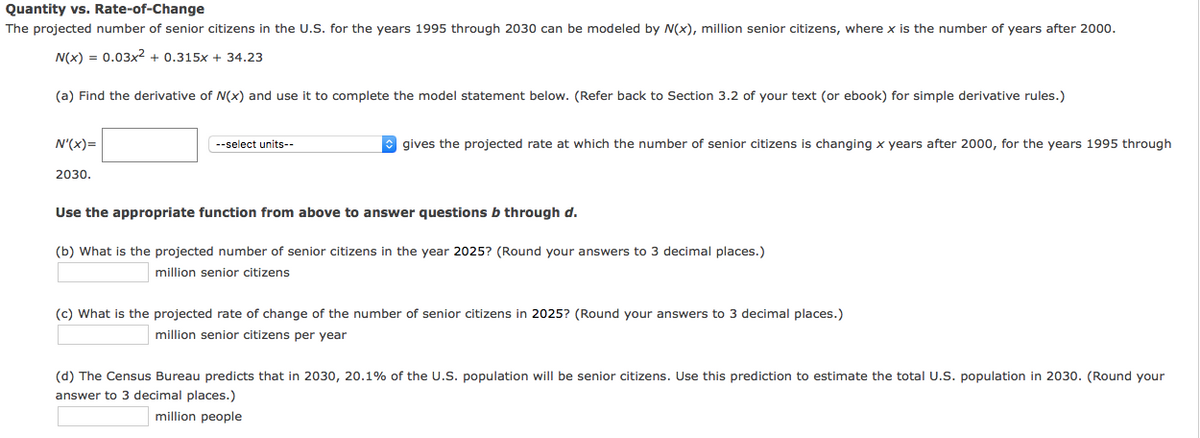The projected number of senior citizens in the U.S. for the years 1995 through 2030 can be modeled by N(X), million senior citizens, where x is the number of years after 2000. N(X) = 0.03x² + 0.315x + 34.23 (a) Find the derivative of N(x) and use it to complete the model statement below. (Refer back to Section 3.2 of your text (or ebook) for simple derivative rules.) N'(x)= 2030. --select units-- gives the projected rate at which the number of senior citizens is changing x years after 2000, for the years 1995 through Use the appropriate function from above to answer questions b through d. (b) What is the projected number of senior citizens in the year 2025? (Round your answers to 3 decimal places.) million senior citizens (c) What is the projected rate of change of the number of senior citizens in 2025? (Round your answers to 3 decimal places.) million senior citizens per year (d) The Census Bureau predicts that in 2030, 20.1% of the U.S. population will be senior citizens. Use this prediction to estimate the total U.S. population in 2030. (Round your answer to 3 decimal places.) million people
The projected number of senior citizens in the U.S. for the years 1995 through 2030 can be modeled by N(X), million senior citizens, where x is the number of years after 2000. N(X) = 0.03x² + 0.315x + 34.23 (a) Find the derivative of N(x) and use it to complete the model statement below. (Refer back to Section 3.2 of your text (or ebook) for simple derivative rules.) N'(x)= 2030. --select units-- gives the projected rate at which the number of senior citizens is changing x years after 2000, for the years 1995 through Use the appropriate function from above to answer questions b through d. (b) What is the projected number of senior citizens in the year 2025? (Round your answers to 3 decimal places.) million senior citizens (c) What is the projected rate of change of the number of senior citizens in 2025? (Round your answers to 3 decimal places.) million senior citizens per year (d) The Census Bureau predicts that in 2030, 20.1% of the U.S. population will be senior citizens. Use this prediction to estimate the total U.S. population in 2030. (Round your answer to 3 decimal places.) million people
Chapter6: Exponential And Logarithmic Functions
Section6.8: Fitting Exponential Models To Data
Problem 1TI: Table 2 shows a recent graduate’s credit card balance each month after graduation. a. Use...
Related questions
Question

Transcribed Image Text:Quantity vs. Rate-of-Change
The projected number of senior citizens in the U.S. for the years 1995 through 2030 can be modeled by N(x), million senior citizens, where x is the number of years after 2000.
N(x) = 0.03x2 + 0.315x + 34.23
(a) Find the derivative of N(x) and use it to complete the model statement below. (Refer back to Section 3.2 of your text (or ebook) for simple derivative rules.)
N'(x)=
--select units--
O gives the projected rate at which the number of senior citizens is changing x years after 2000, for the years 1995 through
2030.
Use the appropriate function from above to answer questions b through d.
(b) What is the projected number of senior citizens in the year 2025? (Round your answers to 3 decimal places.)
million senior citizens
(c) What is the projected rate of change of the number of senior citizens in 2025? (Round your answers to 3 decimal places.)
million senior citizens per year
(d) The Census Bureau predicts that in 2030, 20.1% of the U.S. population will be senior citizens. Use this prediction to estimate the total U.S. population in 2030. (Round your
answer to 3 decimal places.)
million people
Expert Solution
This question has been solved!
Explore an expertly crafted, step-by-step solution for a thorough understanding of key concepts.
This is a popular solution!
Trending now
This is a popular solution!
Step by step
Solved in 6 steps

Knowledge Booster
Learn more about
Need a deep-dive on the concept behind this application? Look no further. Learn more about this topic, calculus and related others by exploring similar questions and additional content below.Recommended textbooks for you


Big Ideas Math A Bridge To Success Algebra 1: Stu…
Algebra
ISBN:
9781680331141
Author:
HOUGHTON MIFFLIN HARCOURT
Publisher:
Houghton Mifflin Harcourt

Glencoe Algebra 1, Student Edition, 9780079039897…
Algebra
ISBN:
9780079039897
Author:
Carter
Publisher:
McGraw Hill


Big Ideas Math A Bridge To Success Algebra 1: Stu…
Algebra
ISBN:
9781680331141
Author:
HOUGHTON MIFFLIN HARCOURT
Publisher:
Houghton Mifflin Harcourt

Glencoe Algebra 1, Student Edition, 9780079039897…
Algebra
ISBN:
9780079039897
Author:
Carter
Publisher:
McGraw Hill

Algebra & Trigonometry with Analytic Geometry
Algebra
ISBN:
9781133382119
Author:
Swokowski
Publisher:
Cengage